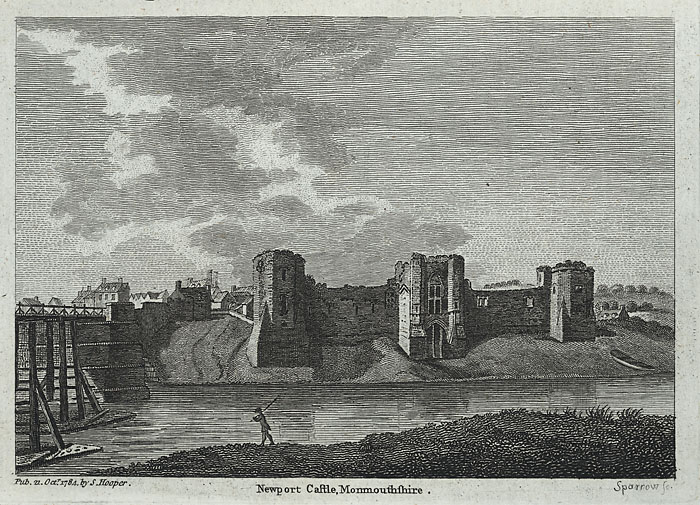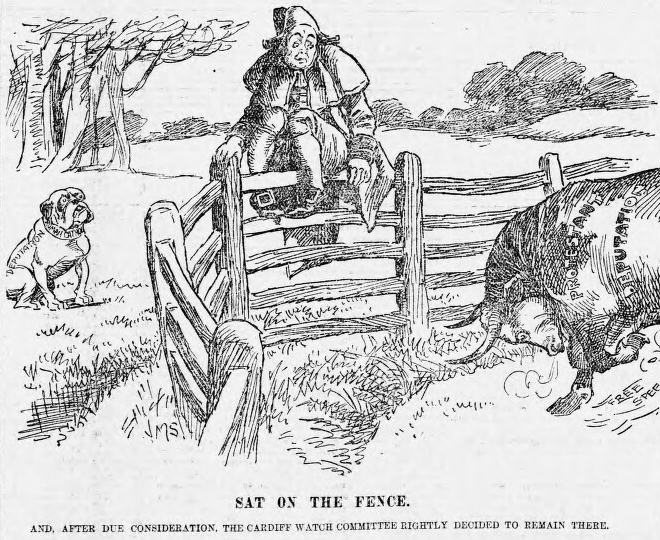|
Newport Borough Police (Monmouthshire)
The Newport Borough Police was the police force for the borough of Newport, Monmouthshire between 1836 and 1967. In 1830 four watchmen were appointed to patrol the streets of Newport for the purpose of maintaining law and order. They also served to protect the people and their property. By 1834 Newport had its first Chief Constable. Sergeant John Redman of the Metropolitan Police Force appeared at a meeting of the Improvement Committee and was duly elected Chief Constable and Prison Bailiff, but it was not until 1836 that the Watch Committee appointed its first regular police force. The first police station was located at the rear of the Parrot Hotel in Commercial Street. Under the control of Chief Constable John Redman, two divisions were created. The 'town' division had a force of eight men and Pillgwenlly division six men, all of whom were unpaid, with the exception of a Pill shoemaker, Rees Rees, who received £25 per annum for executing warrants, serving summonses and carr ... [...More Info...] [...Related Items...] OR: [Wikipedia] [Google] [Baidu] |
Newport, Wales
Newport ( cy, Casnewydd; ) is a city and Local government in Wales#Principal areas, county borough in Wales, situated on the River Usk close to its confluence with the Severn Estuary, northeast of Cardiff. With a population of 145,700 at the 2011 census, Newport is the third-largest authority with City status in the United Kingdom, city status in Wales, and seventh List of Welsh principal areas, most populous overall. Newport became a unitary authority in 1996 and forms part of the Cardiff-Newport metropolitan area. Newport was the site of the last large-scale armed insurrection in Great Britain, the Newport Rising of 1839. Newport has been a port since medieval times when the first Newport Castle was built by the Normans. The town outgrew the earlier Roman Britain, Roman town of Caerleon, immediately upstream and now part of the borough. Newport gained its first Municipal charter, charter in 1314. It grew significantly in the 19th century when its port became the focus of Coa ... [...More Info...] [...Related Items...] OR: [Wikipedia] [Google] [Baidu] |
Monmouthshire (historic)
, Status= Historic countyCeremonial county (until 1974)Administrative county (1889–1974) , Start= 1535 , Origin= Laws in Wales Act 1535 , Motto= Faithful to both (Utrique Fidelis) , Image= Flag adopted in 2011 , Map= , HQ= Monmouth and Newport , Replace= Gwent, Mid Glamorgan, South Glamorgan , Arms= ''Coat of arms of Monmouthshire County Council'' , Government= Monmouthshire County Council (1889–1974)Newport County Borough Council (1891–1974)Cardiff County Borough Council (part) (1938–1974) , Code= MON , CodeName= Chapman code , PopulationFirst= 98,130Vision of Britain �1831 Census/ref> , PopulationFirstYear= 1831 , AreaFirst= , AreaFirstYear= 1831 , DensityFirst= 0.3/acre , DensityFirstYear= 1831 , PopulationSecond= 230 ... [...More Info...] [...Related Items...] OR: [Wikipedia] [Google] [Baidu] |
Metropolitan Police Force
The Metropolitan Police Service (MPS), formerly and still commonly known as the Metropolitan Police (and informally as the Met Police, the Met, Scotland Yard, or the Yard), is the territorial police force responsible for law enforcement and the prevention of crime in Greater London. In addition, the Metropolitan Police is also responsible for some specialised matters throughout the United Kingdom; these responsibilities include co-ordinating and leading national counter-terrorism measures and the personal safety of specific individuals, such as the Monarch and other members of the Royal Family, members of the Government, and other officials (such as the Leader of the Opposition). The main geographical area of responsibilities of the Metropolitan Police District consists of the 32 London boroughs, but does not include the City of London proper — that is, the central financial district also known as the "Square Mile" — which is policed by a separate force, the City of Londo ... [...More Info...] [...Related Items...] OR: [Wikipedia] [Google] [Baidu] |
Watch Committee
In England and Wales, watch committees were the local government bodies which oversaw policing from 1835 until, in some areas, 1968. Establishment The Municipal Corporations Act 1835 required each borough to establish a "watch committee" and to appoint constables to 'preserve the peace'. Disestablishment From 1889 counties switched to using "standing joint committees" which also had magistrates among their members. For police forces working within a single borough, watch committees were retained. The Police Act 1964 replaced both sets of bodies with police authorities, comprising two-thirds elected members of county or borough council A council is a group of people who come together to consult, deliberate, or make decisions. A council may function as a legislature, especially at a town, city or county/shire level, but most legislative bodies at the state/provincial or natio ...s, and one-third magistrates. References {{Reflist * Municipal Corporations Act 1835 * Po ... [...More Info...] [...Related Items...] OR: [Wikipedia] [Google] [Baidu] |
Pillgwenlly
Pillgwenlly ( cy, Pilgwenlli), usually known as Pill, is a community (civil parish) and coterminous electoral district (ward) in the city of Newport, South Wales. Etymology The name is an elision of " Pîl Gwynllyw" (or "Gwynllyw's Pîl" in English). ' Pîl' is a localised topographical element (found across the coast of South Wales, from Pembrokeshire and into Somerset) indicating a tidal inlet from the sea, suitable as a harbour. In local tradition, it is said that this name derives from the early part of Gwynllyw's life when he was an active pirate. The tradition states that Gwynllyw maintained his ships at Pillgwenlly. Gwynllyw's reputation amongst sailors saw him adopted as the patron saint of choice for Welsh pirates and smugglers including Sir Henry Morgan. Description The community is bounded by the River Usk to the east and southeast, the Ebbw River to the southwest, the Great Western Main Line to the west and Cardiff Road to the north. It is an inner-city dist ... [...More Info...] [...Related Items...] OR: [Wikipedia] [Google] [Baidu] |
Warrant (law)
A warrant is generally an order that serves as a specific type of authorization, that is, a writ issued by a competent officer, usually a judge or magistrate, that permits an otherwise illegal act that would violate individual rights and affords the person executing the writ protection from damages if the act is performed. A warrant is usually issued by a court and is directed to a sheriff, a constable, or a police officer. Warrants normally issued by a court include search warrants, arrest warrants, and execution warrants. Types * Arrest warrant, issued by a judge to detain someone * Execution warrant, writ issued by a judge authorizing the death of someone * Possessory warrant, a civil writ issued by a judge ordering property delivered to a named person * Search warrant, a writ issued by a judge allowing law enforcement to look inside a property * Warrant of committal, issued by a judge ordering enforcement of a previous order against an uncooperative person or corporation ... [...More Info...] [...Related Items...] OR: [Wikipedia] [Google] [Baidu] |
Summons
A summons (also known in England and Wales as a claim form and in the Australian state of New South Wales as a court attendance notice (CAN)) is a legal document issued by a court (a ''judicial summons'') or by an administrative agency of government (an ''administrative summons'') for various purposes. Judicial summons A judicial summons is served on a person involved in a legal proceeding. Legal action may be in progress against the person, or the person's presence as witness may be required. In the former case, the summons will typically announce to the person to whom it is directed that a legal proceeding has been started against that person, and that a case has been initiated in the issuing court. In some jurisdictions, it may be drafted in legal English difficult for the layman to understand, while several U.S. states expressly require summonses to be drafted in plain English and that they must start with this phrase: "Notice! You have been sued." The summons announces a dat ... [...More Info...] [...Related Items...] OR: [Wikipedia] [Google] [Baidu] |
Monmouthshire Constabulary
Monmouthshire Constabulary was the Home Office police force for the county of Monmouthshire (excluding the county borough of Newport), United Kingdom until 1967. The force was established in 1857. In 1967 it amalgamated with Newport Borough Police to form Gwent Police Gwent Police ( cy, Heddlu Gwent) is a territorial police force in Wales, responsible for policing the local authority areas of Blaenau Gwent, Caerphilly, Monmouthshire, Newport and Torfaen. The force was formed in 1967 by the amalgamation o .... In 1965, the force had an establishment of 465 officers and also an actual strength of 465, making it the only force in England and Wales that was up to strength.''The Thin Blue Line'', Police Council for Great Britain Staff Side Claim for Undermanning Supplements, 1965 Footnotes Defunct police forces of Wales History of Monmouthshire Government agencies established in 1857 1967 disestablishments in Wales 1857 establishments in Wales Government agencies dis ... [...More Info...] [...Related Items...] OR: [Wikipedia] [Google] [Baidu] |
Gwent Police
Gwent Police ( cy, Heddlu Gwent) is a territorial police force in Wales, responsible for policing the local authority areas of Blaenau Gwent, Caerphilly, Monmouthshire, Newport and Torfaen. The force was formed in 1967 by the amalgamation of Monmouthshire Constabulary and Newport Borough Police. In 1974 its area was realigned to cover the new administrative county of Gwent, and in 1996, it was expanded again to cover the former Rhymney Valley district area that had become part of the Caerphilly county borough. , the force has 1,308 police officers, 70 special constables, 115 police community support officers (PCSO), 40 police support volunteers (PSV), and 647 staff. Organisation Governance Like most police forces in England and Wales, Gwent Police is overseen by the elected Gwent Police and Crime Commissioner (PCC), who replaced the former police authority of councillors, magistrates and lay members in 2012. The PCC is currently Jeff Cuthbert. Structure Gwent Po ... [...More Info...] [...Related Items...] OR: [Wikipedia] [Google] [Baidu] |
Defunct Police Forces Of Wales
Defunct (no longer in use or active) may refer to: * ''Defunct'' (video game), 2014 * Zombie process or defunct process, in Unix-like operating systems See also * * :Former entities * End-of-life product * Obsolescence {{Disambiguation ... [...More Info...] [...Related Items...] OR: [Wikipedia] [Google] [Baidu] |




